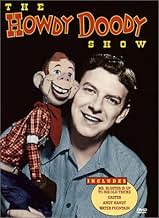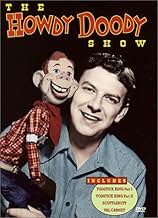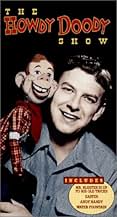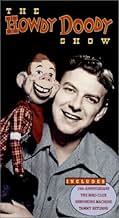अपनी भाषा में प्लॉट जोड़ेंThe first nationally televised American children's TV program and a prototype for what followed. Buffalo Bob Smith hosts while the puppet, Howdy Doody, stars.The first nationally televised American children's TV program and a prototype for what followed. Buffalo Bob Smith hosts while the puppet, Howdy Doody, stars.The first nationally televised American children's TV program and a prototype for what followed. Buffalo Bob Smith hosts while the puppet, Howdy Doody, stars.
- 2 प्राइमटाइम एमी के लिए नामांकित
- 1 जीत और कुल 2 नामांकन
एपिसोड ब्राउज़ करें
फ़ीचर्ड समीक्षाएं
I watched this show everyday when I was a child in the '50s. I was even on the show once as a member of the 'Peanut Gallery'. Kids need more of this type of programming today and less of the pseudo violence and political programming that is labeled as 'kids TV' today. This stirs imagination, which in turn stirs creativity in children. The actors were wholesome people. Bob Keeshan who played 'Clarabell the Clown' for several years, later became successful as 'Captain Kangaroo'. Bob Smith who was also known as 'Buffalo Bob' did a lot of touring and public appearances. He was kind to children, I remember the day that I got to be in the 'Peanut Gallery', I was 8, Buffalo Bob was kind and not at all flustered by a bunch of young children. He seemed to really like kids.
I don't think some of those reviewing this show understand that TV was in the process of being born in the late 1940s and early 1950s. You have to take into account that this was the first experiment in kids' TV programming - the very first attempt to do a show that would entertain kids. Radio people, being the only "broadcasters" around, were basically trying to do their thing - but with cameras suddenly on them. Buffalo Bob Smith invented the Howdy Doody character on radio - the puppet we usually see as Howdy was the second version, the first one having been horribly crude. Budgets were next to nothing. When Buffalo Bob asked NBC to add a clown to the show, they turned him down. He hired Bob Keeshan (who later played Captain Kangaroo on his own program) to play Clarabelle the clown and paid him $5 a week out of his own pocket. To appreciate the impact of this show you need to close your eyes and listen to the content. Doodyville is an imperfect world with many surprises. Phineas T. Bluster is the mayor and the authority figure. He frequently does thoughtless things but often comes to see the error of his ways. Watch practically any episode of the hit show NORTHERN EXPOSURE and see the same character interactions! Contrary to several internet posts, Smith was not a ventriloquist. He simply voiced the puppet, Howdy Doody, when he himself was off-camera. At some point, actor Allen Swift took over the voicing of Howdy to facilitate more live interaction between Bob and Howdy. Those who know the reality of the early days of TV recognize Bob Smith as one of TV's founding geniuses for his insight into children's entertainment.
Howdy Doody went off the air fourteen years before I was born. Until today, I had never seen a single episode. Oh yes, I had seen the clip of Clarabell crying on the last episode, but it was not until today--at age 31--that I saw the show for the first time with my five year-old son.
I can't say that I have ever seen such a quality children's program. Maybe this is because Bob Smith & Co. were trained in radio and live television back in the 1940's, but there was something authentic about their performances. Their diction, their facial expressions, their chemistry, and their interaction with the kids... And then the story lines were not bad either. Plus, after seeing the live commercials, I was expecting my son to ask for Wonder bread.
All you have to do is compare their work product against any children's show today and you will see what I mean. They had a connection with the audience--something the Power Rangers don't have. Frankly, I feel sad for my son's generation, because there is nothing so real on television for him today. Instead of finding role models like Buffalo Bob on TV, all he has are impersonal cartoons; and if, God forbid, he should ever change the channel from these shows, he might find Jerry Springer and Maury Povich.
I can't say that I have ever seen such a quality children's program. Maybe this is because Bob Smith & Co. were trained in radio and live television back in the 1940's, but there was something authentic about their performances. Their diction, their facial expressions, their chemistry, and their interaction with the kids... And then the story lines were not bad either. Plus, after seeing the live commercials, I was expecting my son to ask for Wonder bread.
All you have to do is compare their work product against any children's show today and you will see what I mean. They had a connection with the audience--something the Power Rangers don't have. Frankly, I feel sad for my son's generation, because there is nothing so real on television for him today. Instead of finding role models like Buffalo Bob on TV, all he has are impersonal cartoons; and if, God forbid, he should ever change the channel from these shows, he might find Jerry Springer and Maury Povich.
With that greeting came the arrival of Howdy Doody, a marionette boy and leading citizen of Doodyville. Later on that name was the subject of much
scatalogical humor.
The show's cast divided between marionette creations and some live players in roles. Chief villain of the show was one Phineas T. Bluster the mayor of Doodyville who probably stuffed the ballot boxes. He was a marionette and looked like a Scrooge character. Bluster had all kinds of nefarious schemes which always came up short. A worthy antagonist for the All American Howdy Doody.
Presiding over all of this was Buffalo Bob Smith who hailed from Buffalo, New York. He did it with grace and tact and never talked down to the kid audience. I remember that he had a real heart attack at one point in the 50s. A guy named Bison Bill came in for a bit and Smith's return was welcomed.
Buffalo Bob was assisted by Clarabelle The Clown played by Bob Keeshan who went straight into Captain Kangaroo when Howdy Doody finished its run of 13 years. Clarabelle the Clown usually ended quarrels with those oldfashioned seltzer bottles with the spritzers.
It was a great kid's show, just about in the boomer generation saw it.
The show's cast divided between marionette creations and some live players in roles. Chief villain of the show was one Phineas T. Bluster the mayor of Doodyville who probably stuffed the ballot boxes. He was a marionette and looked like a Scrooge character. Bluster had all kinds of nefarious schemes which always came up short. A worthy antagonist for the All American Howdy Doody.
Presiding over all of this was Buffalo Bob Smith who hailed from Buffalo, New York. He did it with grace and tact and never talked down to the kid audience. I remember that he had a real heart attack at one point in the 50s. A guy named Bison Bill came in for a bit and Smith's return was welcomed.
Buffalo Bob was assisted by Clarabelle The Clown played by Bob Keeshan who went straight into Captain Kangaroo when Howdy Doody finished its run of 13 years. Clarabelle the Clown usually ended quarrels with those oldfashioned seltzer bottles with the spritzers.
It was a great kid's show, just about in the boomer generation saw it.
Howdy Doody" was the first television show I ever remember watching as a very young kid. I hadn't seen it in about 55 years so, at first, it was kind of shocking to view a few episodes just the other day. A new DVD by Mill Creek Entertainment came out last last year (2008) and contains a number of episodes from 1949-1952 and all of them with pretty good transfers.
The show is not something I could enjoy now as a 60-plus-year-old man, but it was interesting to see the principal characters again. I viewed three of the episodes and, frankly, that was enough. It was fascinating to look back, though. I can't believe how the plugs they did for their sponsors, like Halo Shampoo or Three Muskateeres candy bar, were worked into an audience-participation thing. It's so different from what we've known the last 40 years. Instead of cutting away to a commercial, they plugged the products as part of the show.
Speaking of participation, I had also forgotten exactly how young the audience - the famous "Peanut Gallery" - was, the kids all looking about five years old. This was definitely a show for very young kids. The only part that I still enjoyed was the old silent film comedies. In each half-hour Howdy Doody episode, they showed a silent-film comedy with Buffalo Bob explaining some of the things going on. The old slapstick films are still funny, of course.
It also looked like the show did a lot to promote the American Indian. Yeah, they might have been white men dressed up as Native Americans, but there were a number of characters in this show and they were not portrayed negatively. They were live humans and puppets.
The other "live" people included a star of the show: "Clarabell" The Clown. Clarabell was like Harpo Marx, a silent pantomime figure who honked instead of spoke and made a lot of faces, many of them sad. He was first played by Bob Keeshan, who went on to big fame as "Captain Kangaroo."
The only thing that baffled me was seeing "Princess Summerfallwinterspring," whom I always remembered as a beautiful young women. Here, she's a puppet. I did some research, though, and found out she started out as a puppet on this show and then became a real-life human, played by Judy Tyler. By the way, Tyler played opposite Elvis Presley in the 1957 film, "Jailhouse Rock." Tragically, the woman and her husband were killed later that year in a car crash. Elvis said he could never watch that movie again, because seeing Judy would be too much to bear.
All in all, I still can't have anything but the fondest thoughts for this show, which first brought me the joys of television entertainment. Buffalo Bob Smith will always be a folk-hero of sorts to me, and millions of other Baby Boomers.
The show is not something I could enjoy now as a 60-plus-year-old man, but it was interesting to see the principal characters again. I viewed three of the episodes and, frankly, that was enough. It was fascinating to look back, though. I can't believe how the plugs they did for their sponsors, like Halo Shampoo or Three Muskateeres candy bar, were worked into an audience-participation thing. It's so different from what we've known the last 40 years. Instead of cutting away to a commercial, they plugged the products as part of the show.
Speaking of participation, I had also forgotten exactly how young the audience - the famous "Peanut Gallery" - was, the kids all looking about five years old. This was definitely a show for very young kids. The only part that I still enjoyed was the old silent film comedies. In each half-hour Howdy Doody episode, they showed a silent-film comedy with Buffalo Bob explaining some of the things going on. The old slapstick films are still funny, of course.
It also looked like the show did a lot to promote the American Indian. Yeah, they might have been white men dressed up as Native Americans, but there were a number of characters in this show and they were not portrayed negatively. They were live humans and puppets.
The other "live" people included a star of the show: "Clarabell" The Clown. Clarabell was like Harpo Marx, a silent pantomime figure who honked instead of spoke and made a lot of faces, many of them sad. He was first played by Bob Keeshan, who went on to big fame as "Captain Kangaroo."
The only thing that baffled me was seeing "Princess Summerfallwinterspring," whom I always remembered as a beautiful young women. Here, she's a puppet. I did some research, though, and found out she started out as a puppet on this show and then became a real-life human, played by Judy Tyler. By the way, Tyler played opposite Elvis Presley in the 1957 film, "Jailhouse Rock." Tragically, the woman and her husband were killed later that year in a car crash. Elvis said he could never watch that movie again, because seeing Judy would be too much to bear.
All in all, I still can't have anything but the fondest thoughts for this show, which first brought me the joys of television entertainment. Buffalo Bob Smith will always be a folk-hero of sorts to me, and millions of other Baby Boomers.
क्या आपको पता है
- ट्रिवियाThis was the first nationally televised American children's television show.
- भाव
[final episode. Clarabell speaks for the only time in the show's history]
Clarabell the Clown: Goodbye, kids.
- कनेक्शनFeatured in Television Land (1971)
टॉप पसंद
रेटिंग देने के लिए साइन-इन करें और वैयक्तिकृत सुझावों के लिए वॉचलिस्ट करें
- How many seasons does The Howdy Doody Show have?Alexa द्वारा संचालित
विवरण
- रिलीज़ की तारीख़
- कंट्री ऑफ़ ओरिजिन
- भाषा
- इस रूप में भी जाना जाता है
- The Howdy Doody Show
- फ़िल्माने की जगहें
- उत्पादन कंपनी
- IMDbPro पर और कंपनी क्रेडिट देखें
- चलने की अवधि30 मिनट
- ध्वनि मिश्रण
- पक्ष अनुपात
- 1.33 : 1
इस पेज में योगदान दें
किसी बदलाव का सुझाव दें या अनुपलब्ध कॉन्टेंट जोड़ें






























